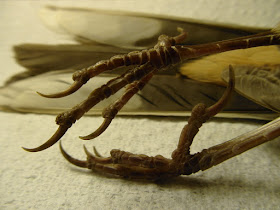During the 5 a.m. hour on a Saturday morning, it was time for another dead bird patrol. Among the always significant findings was a Spotted Towhee.
A dead bird of this species was at the Holland Performing Arts Center. In particular it was next to the glass of the west-facing wall at the southeast corner of the interior courtyard. Nearby was a Nashville Warbler, injured after hitting a wall of glass and trying to fly well enough to get away from the scene. It was seen to bounce off the glass some few times, before a particular effort was made to guide it onward from the glass and confusing lighting.
Since it was Saturday, the bird patrol man wasn't working, so it was easy to document both window strikes, on a chilly morning. There was no subterfuge underway by building employees.
As the day transpired, some time was spent in the afternoon being indoors at the Joslyn Art Museum, whereas it may have been preferable to be at the wachipi at Fort Omaha. Indoors the speakers spoke, using words of a relative degree, about the profound efforts of Prince Maximilian, a German visitor so instrumental in expressing history of the Missouri River during the historic period. Karl Bodmer was at least mentioned a time or two.
It cost $8 to enter the museum. There was nothing lost for the time, but nothing was learned from what the featured speakers said, and from their e-powered powerpoint presentations. At least there was free parking for people riding bicycles.
A couple of tidbits were none-the-less of some importance, but which significance depends.
The editor of Prairie Fire Newspaper was trying to find some writer to replace their current regular contributor of bird stories. Dr. Paul Johnsgard, a retiree of UNL was not writing anything "fresh." An introduction to this editor came from Robert Kuzelka, another longtime UNL employee, in search of a purpose.
During the time of speakers, there was no new wonder or fresh vitality for the expedition journals. The hours were gone, especially after more pedal strokes happened, so it eventually was later on a Saturday afternoon.
Then it was evening, and a unique surprise. In the local Carthage neighborhood,. it was a complete surprise to see a towhee in the backyard. There were robins, grackles and a few starlings on the scene, enjoying the bird bath. Some House Sparrows also appreciated the fresh water.
The spots of the towhee were obvious, then confirmed with a closeup perspective using a spotting scope. The carcass of earlier in the morning added to the significance. This bit of expressive bird activity represents species no. 68 for the Carthage neighborhood. Its occurrence was especially emphasized by the early morning finding of the carcass of a dead bird at the Holland Performing Arts Center..
In the local environs at the bluffs of Carthage and Dundee, particular attention was given to this bit of a bird, oblivious to record-keeping. Before doing dinner dishes, its id was easily confirmed with a closer look using a spotting scope.
During this same period of time, an avian congregation of grackles, robins and house sparrow appreciated the fresh water in the blue bowl. It is a joy to see them sip.
These particular observations are special because two days later, the Brown Thrasher was about the same ground.
Once the live bird antics ended, some time was taken to consider particular apropos for historic bird observations, including a pause necessary to get details correct for a particular date and other specifics.
As dusk spread over the River City scene, after 7 p.m., once again a bicycle was ridden to a place where there were many Chimney Swifts, over in the Izard Industrial Zone.
Dozens and dozens of bug-eaters gathered about at the place which they had selected as a night's haven. The display was appreciated along Izard Street.
After watching the wonderful birds and soon thereafter moving to return to my residence — while walking rather than bicycle riding — trash along the street was picked up, then thrown into local dumpsters.
